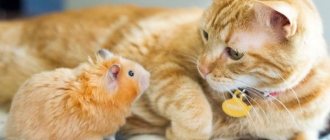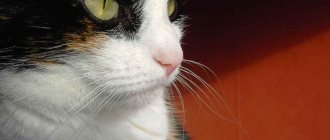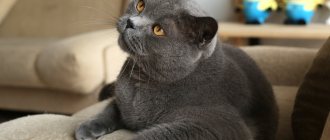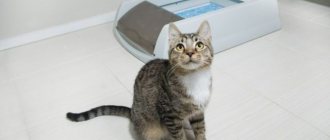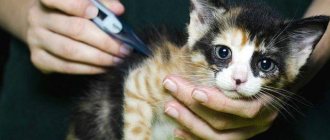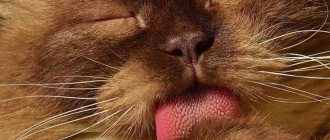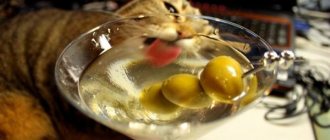“The cat wants cum!” - this line from a children's poem comes out of nowhere in the minds of many people, no matter whether they have a pet or have never had one. The very first thing that comes to mind when you see a homeless kitten is to fuck the baby with a saucer of milk. Many cat lovers attribute human emotions and needs to their pets, and this extends to eating habits. Why not give your furry companion the same treat that his owner likes, for example, ice cream?
From the history of cat nutrition
Industrial feed has recently appeared in stores nearby. For centuries, cats have eaten the same foods as humans. The difference was in the absence of heat treatment: poultry and fish were often served raw. They did not spare milk; in some cases they even crumbled bread into it. In the 1930s, veterinarians began to suggest that owners reconsider established views on animal nutrition and hide milk and carbohydrates in the form of food from the cat’s menu. The cat is a predator whose diet should consist of lamb and drink only water.
Views on feeding have changed, without further ado, most animal lovers simply buy ready-made butts, dry or wet. Fortunately, the choice is quite wide. But, noticing their pet’s interest in dairy products and ice cream treats, many people wonder if they should start spoiling their purr with treats on a regular basis? But is it harmful to give ice cream to your cat? It is worth considering the known facts.
Are animals really interested in sweets?
A small amount of any treat will not harm a healthy cat. There is clearly no point in pouring a full bowl of ice cream: such a dish should not replace even one full meal. The evolution of the tailed animals went well: cats, unlike people, do not distinguish between sweet tastes. They will easily not be able to enjoy food that contains sugar or sugar substitutes. Moreover, the cat’s body does not produce insulin, which is needed to process sugars. Sweets are simply not digestible.
Cats are attracted to the milky smell, familiar from birth. The increased fat content of the product also plays an important role: cats instinctively understand that pure food like this will fill them up faster.
When does a cat need sugar?
In rare cases, a cat needs sugar as medicine.
This phenomenon occurs during the recovery period of an animal after a serious illness, when it is exhausted and there is a reduced level of sugar in its blood compared to what it should be normally. However, sweet medicine can only be used as prescribed by a veterinarian. The cat owner himself should not prescribe such therapy. In this situation, the cat is given a glucose solution or regular sweetened water. During such treatment, strict monitoring of the animal’s condition is required in order to promptly stop the supply of sweets. Even during treatment, the following sweets are prohibited for the animal:
- confectionery;
- sweet dairy products;
- chocolate;
- sweet carbonated drinks (some cats readily drink them).
In order not to harm your pet, you must strictly follow all the veterinarian’s recommendations. If the cat is not ready to drink sweetened water, it may be forced to drink it. It is also not uncommon to resort to the simplest method and give the pet IVs with glucose, which can be not only intravenous, but also subcutaneous.
Harm from ice cream
If the owner often pampers the pet with ice cream, he will have to go to the veterinarian at dawn or later. Cats, like humans, digest milk well in childhood, but with age they lose this ability: the level of the enzyme lactase, which is responsible for the thermal absorption of the milk sugar lactose, is very low in most adult animals. Yes, there are animals that can eat dairy products and feel great. The majority of cats will suffer from indigestion: suffer from bloating, pain and diarrhea, because milk, in contact with gastric juice, coagulates without breaking down into components. Liquid matter passes through the entire intestinal tract and irritates its walls. Benthos becomes dehydrated , not only the digestive system suffers from this. This means that constantly feeding your pet ice cream is prohibited.
When an animal eats tasty, but not the healthiest food, it becomes full and does not receive the components necessary for health, such as taurine, an essential amino acid. This is something to keep in mind.
Properties of fats | Food | THAI CATS AND KITTENS. Thai Cat Club
Natalie Thai, Thai Cat Club
Fats are sources of energy and a necessary part of a cat’s diet.
They are carriers of fat-soluble vitamins A, D, E, K and suppliers of fatty acids (linolenic, lenoleic, arachidonic), which are not produced in their bodies.
With a deficiency of these acids in animals, growth stops, reproduction processes are disrupted, and the condition of the skin worsens (keratosis, thickening of the epidermis and peeling of the skin).
Cats really like fats; they are easily digested, reduce the rate of gastric emptying, and also contribute to a feeling of fullness after eating. Young cats that receive enough dietary fat grow and develop much better than those that are deficient.
There should be significantly more fat in a cat's diet than in a dog's diet.
Thai cat Maximilian
Photo © torine69, Leningrad region
Thai Cat Club
The most valuable fats are those containing vitamins. These fats include: egg yolk fat, bone fat, fish fat, perirenal and perihepatic fats. Less valuable to predators are pork and lamb lard, vegetable oils and margarine. For example, arachidonic acid, so necessary for cats, is found only in fish and poultry fats and is not part of vegetable fats.
However, when animals consume excessive amounts of fat, not only obesity can develop, but also various diseases of the liver, pancreas and gastrointestinal tract of cats.
For young cats, a food containing 10-30% fat based on dry matter (DM) . If the cat is obese, then this figure drops to 8-7%. However, in older cats this figure rises to 10-25%. The fact is that the ability to digest fat in cats decreases with age, so fats in older cats should be easily digestible.
Fat-soluble vitamins
Fat-soluble vitamins A, D, E, K are absorbed only with fat.
Vitamin A
Vitamin A promotes the growth of body cells and helps resist infection. With its participation, vision is sharpened in light of varying intensities. Cats are unable to synthesize this vitamin, so it should be added to their food in one way or another. It is found in egg yolk, fish oil, carrots, green vegetables, grass and seaweed.
Vitamin D
Vitamin D is known as the sun vitamin because it requires sunlight to be synthesized.
It promotes the formation of healthy bones, and cats can synthesize it while sitting in the sun or under ultraviolet rays.
(Be careful, however, if you expose your cat to the sun; ultraviolet rays can cause his fur to fade.) Vitamin D is found in high amounts in fish oil.
Vitamin E
Promotes the development of reproductive functions in males and females and the muscular system, the prevention of infectious diseases, and in obese cats it helps eliminate fat deposits in tissues. Contained in products of plant and, partly, animal origin, mainly in vegetable oils.
In the absence and insufficiency of vitamins E, membrane permeability is impaired (in particular, the release of lysosomal enzymes is hampered).
This, in turn, can cause degenerative processes in the germinal epithelium, impaired spermogenesis, death of embryos in the early stages of development, and anemia in low-birth-weight newborns.
Vitamin K
Vitamins of group K are necessary for normal blood clotting. Contained in dairy and meat products, liver, eggs. A deficiency of vitamins K in the body leads to the development of hemorrhagic syndrome. Vitamin K deficiency can develop with cholelithiasis, with prolonged oral use of antibiotics, with prolonged intravenous nutrition.
Fatty acid
Among the essential (i.e., those that the body cannot synthesize) fatty acids (EFAs), the main role is played by omega-6 and omega-3, including linoleic and alpha-linolenic and arachidonic acids. These are essential fatty acids that play the role of precursors for the synthesis of other components necessary for the normal functioning of the body.
EFAs are also known as vitamin F. Vitamin F is used in scientific and patent literature, in advertising brochures and technical documentation to refer to lipid preparations containing fatty acids.
In animals, with a lack of OMEGA-3 and OMEGA-6 EFAs, those cells that have the highest renewal rate are primarily affected. The structure and function of the epithelium of the mucous membranes and skin is disrupted.
This predisposes to the occurrence of diseases of the digestive tract, respiratory and reproductive systems. Skin damage is also typical: dermatological disorders occur, and there is a predisposition to mite infestation.
The coat becomes dull, loses its shine and thickness, dandruff appears, and the appearance of the animal significantly deteriorates.
It is recommended to add EFAs to the diet when feeding animals with economy-class feed, during natural feeding, during molting, lactation, pregnancy, during stress, before exhibitions, and during critical periods of an animal’s life . Pet owners usually note that this stimulates digestion and improves appetite. Polyunsaturated fatty acids are especially important in the system of measures for the prevention of liver diseases.
The best natural sources of polyunsaturated essential fatty acids: vegetable oils from wheat ovary, flaxseed, sunflower, safflower, soybeans, peanuts; avocado, oatmeal, corn, brown rice. All vegetable oils must be first cold pressed, unfiltered, undeodorized (i.e., retain their odor).
Cats require a dietary supply of three essential fatty acids: linoleic, linolenic and arachidonic.
Linoleic acid
Eicosapentaenoic and decosahexaenoic acids are formed from linoleic acid, which are involved in the regulation of metabolic (metabolic) processes, the synthesis of prostaglandins (inflammatory mediators), in the construction of cell membranes, lower the level of cholesterol and triglycerides, reduce the risk of thrombosis, normalize the functioning of the endocrine glands, and have an anti-inflammatory effect , regulates the sexual cycle.
Linolenic acid
Linolenic acid plays an important role as an anti-inflammatory agent and enhances the activity of animals, especially aging ones.
Arachidonic acid
Arachidonic acid is one of the important fatty acids. Arachidonic acid helps regulate the formation of new skin cells, and also serves to normalize blood clotting, the functioning of the reproductive and gastrointestinal systems. Arachidonic acid is found in animal fats and should be included in your cat's diet.
Most animals (except cats) can obtain arachidonic acid from linoleic acid. Therefore, it is necessary to add foods containing arachidonic acid to the cat's diet.
Thai cat Funtik
Photo © Julia0202, Pinsk, Belarus
Thai Cat Club
| Fat/Oil | Linoleic acid | Linolenic acid | Arachidonic acid |
| Safflower oil | 73-79% | – | |
| Grape seed oil | 72% | 1% | |
| Hemp oil | 60% | 18-20% | 2% |
| Sunflower oil | 42-62% | 1-3% | |
| Mustard oil | 32% | 14% | – |
| Linseed oil | 20% | 61% | |
| Olive oil | 10% | ||
| Coconut oil | 1-2% | 3-6% | |
| Poultry fat | 22.3% | 2% | 1% |
| Fish fat | 2.7% | 29% | 25% |
| Beef fat | 4.3% | 0.2% |
What sweets can you give without danger?
You can give your four-legged friend ice cream made from goat's milk with added vanilla. Goat's milk is always pasteurized, so it contains enzymes that help the body digest lactose.
It’s easy to make the seeds yourself: just add a little sugar to the new milk and give the mixture to the cat. Allowed to do without freezing. Just don’t leave things to chance: goat’s milk can also cause diarrhea, so after tasting the animal you need to keep a close eye on it.
Brain freeze...
Write down the opinion that ice cream can give a cat a cold in the brain. It sounds ridiculous, but the likelihood that animals may become ill from eating too cold food is not zero, and we are not talking about a cold. Low food temperature can lead to vasoconstriction, and this can cause headaches, especially in kittens, whose nervous system is very vulnerable.
So, it is best to give ice cream to cats occasionally and a little at a time. Preferably creamy or vanilla. If the animal owner has doubts and is afraid of the pet’s health, it is better either not to treat the cat to an unsafe dish, or to ask a veterinarian for advice. In addition, in stores you can find a wide variety of special treats that are fragrant, tasty and healthy for cats.
